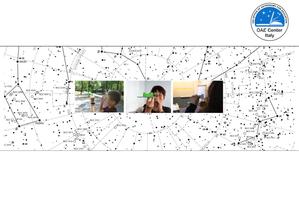Glossarbegriffe: Winkelausdehnung
Description: Die Winkelausdehnung eines Objekts ist sein scheinbarer Durchmesser von einem bestimmten Standpunkt aus. Sie wird als Winkel gemessen und in Grad, Bogenminuten und Bogensekunden angegeben. Die Astronomie verwendet den scheinbaren Durchmesser von Himmelskörpern, um ihre Größe am Himmel auszudrücken. Diese scheinbare Größe eines Himmelsobjekts nimmt zu, je größer der Himmelskörper selbst ist. Sie nimmt ab, wenn ein Objekt weiter entfernt ist. Ein Beispiel: Die Sonne und der Mond haben von der Erde aus gesehen beide eine Winkelausdehnung von rund einem halben Grad. Zwar ist der Mond rund 400 Mal kleiner als die Sonne, erscheint uns aber gleich groß, weil die Sonne etwa 400 Mal weiter von uns entfernt ist.
See this term in other languagesTerm and definition status: The original definition of this term in English have been approved by a research astronomer and a teacher The translation of this term and its definition is still awaiting approval
The OAE Multilingual Glossary is a project of the IAU Office of Astronomy for Education (OAE) in collaboration with the IAU Office of Astronomy Outreach (OAO). The terms and definitions were chosen, written and reviewed by a collective effort from the OAE, the OAE Centers and Nodes, the OAE National Astronomy Education Coordinators (NAECs) and other volunteers. You can find a full list of credits here. All glossary terms and their definitions are released under a Creative Commons CC BY-4.0 license and should be credited to "IAU OAE".
If you notice a factual or translation error in this glossary term or definition then please get in touch.
Related Activities
The sky at your fingertips
astroEDU educational activity (links to astroEDU website) Description: Build a simple cross-staff and measure the stars!
License: CC-BY-4.0 Creative Commons Namensnennung 4.0 International (CC BY 4.0) icons
Age Ranges:
10-12
, 12-14
Education Level:
Middle School
, Primary
Areas of Learning:
Informal/Field Trip Related
, Observation based
, Project-based learning
Costs:
Low Cost
Duration:
2 hours
Skills:
Analysing and interpreting data
, Developing and using models









